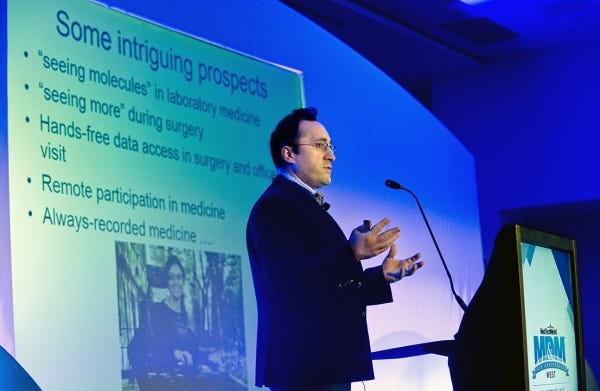Amazon VP on Why Future Wearables Will Be Magical
February 11, 2015
There's no telling what wearable computing devices will look like 20 years from now. But we can count on computers to get smaller and more personal as they evolve.
Brian Buntz
|
Babak Parviz explained in an MD&M West keynote address why wearables will matter for medtech and other tech fields. |
Just take a look at how computer have evolved in the past half century. Forty to 50 years ago, computers were warehouse sized and you had to get in a car to go drive to them, said Babak Parviz, vice president at Amazon, in a keynote address at MD&M West on Tuesday, February 10. (Or, if you were Bill Gates as a teenager, you would sneak out of your family's house in the middle of the night, and ride a bike to your neighborhood mainframe.)
Apple launched its first computer in 1976. And debuting in 1981, IBM's desktop personal computer was also a trailblazing device.
The first computer described as a laptop came out a couple of years later, and by the 1990s, laptop computers could fit fairly comfortably in a backpack or briefcase.
"Even before the Internet, these devices were useful but after connectivity arrived, they became exponentially more useful," Parviz says.
Now, the smartphones we hold in our pockets are immensely powerful machines based on the standards of decades past. They would look magical for someone in the 1990s.
Now, it's worth considering where this technology will take us. Twenty years from now, the wearables of the future will look magical by today's standards, and will make our current-gen smartphones look rudimentary.
Wrist-worn devices, like Apple's forthcoming smartwatch, are one example of a promising form factor for wearables.
But of course, Google, Parviz's former employer, also has looked into the question, and Parviz was personally involved in the development of the first version of Google Glass.
Glass, although an experimental head-worn computing device, could give us an indication of where the future of wearables is headed. (The Mountain View, CA-based tech giant is now said to be working on the second generation of the technology--after a rollercoaster ride for the first version that The New York Times described as a story with "lots of public intrigue.")
Parviz says the device represents another step in computing platforms becoming more personalized. "It interacts with you and the environment," he said. It can overlay visual information on top of the environment and interact with its wearer using sound, as it comes equipped with both internal microphones and speakers.
It is also an example of the power of miniaturization. The first iteration of the head-worn device had a dual core processor and a few GB of memory. In addition, the device is packed with a range of sensors and wireless capabilities, including Bluetooth, Wi-Fi, and GPS. It can detect if its wearer blinks or not.
"And very importantly, it has a camera that sees the world through your eyes, " Parviz says.
There has been considerable interest in Google Glass in the medical realm.
One of the most exciting aspects of technologies like Glass for medical applications is that future versions of the technology could give users near instantaneous access to relevant medical information. "If I look at how I answered questions 20 years ago, I would go look for a book. Sometimes, it would take days to find the answer to a question," Parviz said. But a cloud-connected wearable device could speed that processes up to the point it is nearly instantaneous.
The other potential of head-mounted technologies like Glass is that they can enable clinicians and researchers see much more than they could see with the naked eye alone. Surgeon with Glass might be able to see the molecules within the tumor they are operating on. Or chemists in the lab could use it to facilitate research on, say, immunoassays.
Hands-free data access could be useful for doctors--whether they are in the operating room or in an office visit.
The technology could also be useful for people with disabilities, where it could be used to facilitate everyday activities that may be nevertheless challenging. "This is a very good use case," Parviz noted.
For now, however, the most promising example of a wearable device is the smartphone, Parviz said. The latest smartphones have what would have been a state-of-the-art digital camera 20 years ago. And there has been immense progress with regards to data connectivity. Remember that about 15 years ago, phones were still used for phone calls. Now, we have a cloud-connected supercomputer available at our fingertips that can be used for everything from playing Angry Birds to taking your ECG.
Hear from other medical device experts in the MD&M West conference lineup in Anaheim, CA, held February 10-12. |
Brian Buntz is the editor-in-chief of MPMN and Qmed. Follow him on Twitter at @brian_buntz.
Like what you're reading? Subscribe to our daily e-newsletter.
About the Author(s)
You May Also Like



